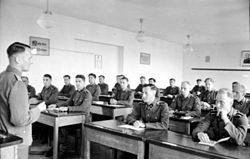SS Junker
SS-Junker or Staffeljunker was in the German Reich from 1933 to 1945 the designation for the lowest rank of the leader candidates , comparable to the SS-Unterscharführer , who were ranked in the rank group of Unterführer of the Waffen-SS or SS- ordnance.
origin
With the formation of the SS available troops , their increasing militarization and the emergence of the Waffen-SS , the need arose to train, supplement and expand loyal leadership personnel in the form of SS leaders. Since the focus here was primarily on imparting military knowledge for the formation, growth and staffing of SS elite associations, comparable procedures were adopted, including the hierarchy and rankings of the officer candidates from the Reichswehr . In addition, leading leaders of the Waffen-SS had previous service periods in the Reichswehr and had experience in training the next generation of leaders.
In earlier armies and armed forces that used German military terms (including the Austro-Hungarian army and the Russian army), Fahnenjunker referred to the officer candidates of the infantry and the dragoons . In the cavalry they were called Standartenjunker. The terminology was adopted by the SS and is reflected in the system of rank designations of the SS leader candidates.
Education and ranking
For potential leader candidates, the obligation period was 25 years and they had to have served with the teams for at least two years . Membership in the NSDAP or the Allgemeine SS was irrelevant for the selection of a possible SS leader in the SS-Einsatzstruppe (and later the Waffen-SS ). In general, there was a commitment period of four years, unless the possible SS leader could look back on an earlier military career in the Reichswehr and / or Wehrmacht , as was the case with Paul Hausser, for example .
The SS Junkers went through a predetermined selection process before a possible promotion to / or instruction in the lowest rank of SS Junker. During this time, appropriate instruction, courses and examinations, including the so-called Aryan certificate and a compulsory course at a driving school or SS Junk School in Braunschweig or Bad Tölz, took place . Despite the long duration of the engagement and the tough physical, moral and racial requirements, there were enough volunteers.
After successful completion, he was appointed SS-Untersturmführer , the lowest leadership rank of the SS. Towards the end of the war, the prescribed regulations were increasingly deviated from. The training times were shortened and even compulsory attendance at the Junker School was suspended.
The illustrations show the badges of rank or rank badges that were worn as shoulder pieces and collar tabs , but also as sleeve badges from 1942 for camouflage or special suits. Similar to the Wehrmacht, there were four SS Junker ranks. Since 1933 there have been different definitions regarding the shoulder pieces.
Badge of rank of the candidate leaders of the Waffen SS
The following overview shows the badges of rank of the candidate leaders of the Waffen-SS. Since 1942, two nine-millimeter-wide, parallel silver-colored strands (so-called hope bars) - as can be seen in the Oberjunker and Standartenjunker - have been worn on the shoulder pieces.
| Collar Tabs | Shoulder piece | Special clothing |
Rank designation | Rank designation (equivalent) |
Shoulder piece |
|---|---|---|---|---|---|
|
|
SS-Standartenoberjunker (OR-7) | SS-Hauptscharführer | |||
| SS-Standartenjunker (OR-6) | SS-Oberscharführer | ||||
|
|
SS-Oberjunker (OR-5) | SS squad leader | |||
|
|
SS Junker (OR-4) | SS-Unterscharführer |
- annotation
- OR stands for the English Other [Enlisted] Ranks and follows fixed NATO rank codes .
See also
- Illustration of the ranks and insignia of the Waffen SS
- NS ranks
- SS ranks
- Officer ranks of the Wehrmacht
References and comments
- ↑ Gordon Williamson: The SS - Hitler's Instrument of Power. 1994, p. 34.
- ^ Johann Georg Krünitz: "Oeconomische Encyclopädie", 1773-1858, p. 338
- ↑ Gordon Williamson: The SS - Hitler's Instrument of Power. 1994, p. 36
- ^ Dictionary of German military history. 1st edition. Military Publishing House of the GDR, Berlin 1985, p. 145 Rank badge 29/30.
- ↑ Cf. NATO glossary abbreviations used in NATO documents and publications / Glossaire OTAN des abréviations utilisées dans les documents et publications OTAN ( Memento of May 8, 2010 in the Internet Archive )




